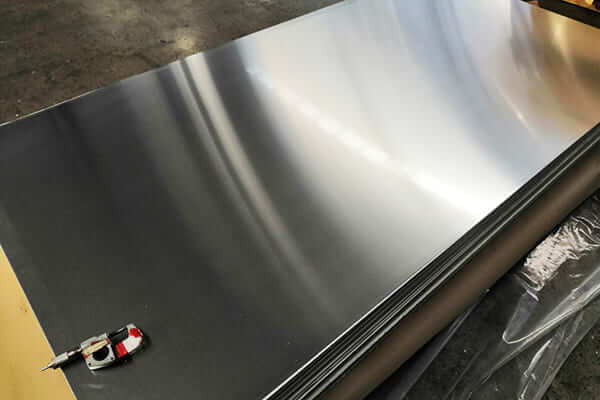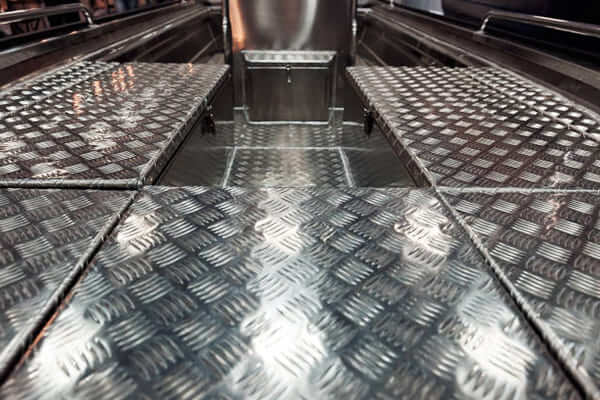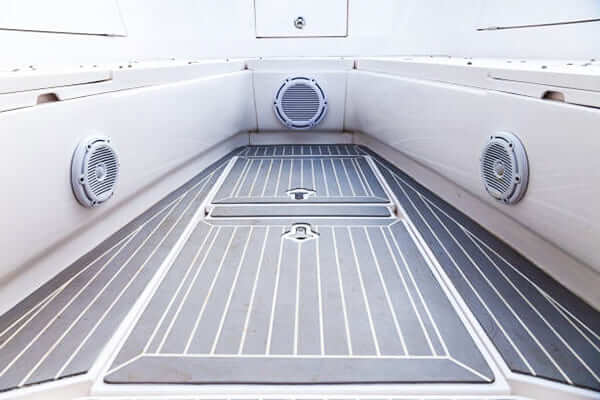Boat owners and naval architects recognize that aluminum sheets for boat decking deliver unmatched performance in marine environments.
Decking materials must endure constant UV exposure, saltwater spray, and heavy foot traffic.
Consequently, specifiers increasingly favor aluminum over traditional substrates such as teak, composite, or steel.
Beyond its corrosion resistance, aluminum offers a superior strength-to-weight ratio that enhances vessel stability and fuel efficiency.

Hliníkové listy na palubu lodí
When you choose aluminum sheets for boat decking, alloy choice dictates long-term performance:
| Zliať | Mg (%) | A (%) | Key Benefit | Marine-Grade Spec | Typical Use |
|---|---|---|---|---|---|
| 5052 | 2.2–2.8 | ≤ 0.25 | Excellent pitting resistance | DNV-GL: ≤ 3 % Mg* | Light-duty deck panels, interior liners |
| 5086 | 3.5–4.5 | ≤ 0.25 | Superior seawater resistance | ABS: Blesk 3.5 % Mg, H116 | Primary deck plating, offshore walkways |
| 5754 | 2.6–3.6 | ≤ 0.40 | Enhanced formability & weld-ability | Lloyd’s: ≥ 2.7 % Mg, H321 | Complex curved decking, tight-radius bends |
| 6061-T6 | 0.8–1.2 | 0.4–0.8 | High structural strength | ISO 9001 certified mills | Load-bearing deck sections, mounting bases |
*DNV-GL allows magnesium up to 3 % for general marine alloy classification.

Huawei 5086 Aluminum Sheet for Boat Decking
The temper designation (Napr., -H32, -H116, -T6) indicates the mechanical and thermal treatments the aluminum has undergone, which significantly affect its properties:
The decision to use aluminum for boat decking brings a multitude of compelling advantages.
Marine-grade aluminum alloys possess an excellent strength-to-weight ratio.
Napríklad, 5083-H116 can have an ultimate tensile strength of over 300 MPA (44 ksi).
This allows for robust deck structures that can withstand significant loads from passengers, vybavenie, and dynamic sea forces, ensuring long-term structural integrity.
Aluminum is approximately one-third the density of steel (around 2.7 g/cm³ vs. 7.85 g/cm³ for steel). This significant weight saving translates to:
Unlike wood decking which requires regular sanding, sealing, and varnishing, or fiberglass which can suffer from gel coat crazing or osmosis, aluminum decking is remarkably low maintenance.
It does not rot, warp, splinter, or succumb to insect infestation. Routine cleaning with fresh water and mild soap is typically all that is required.
When the correct marine-grade alloy is chosen and properly installed (addressing galvanic corrosion, napríklad), an aluminum deck can last the lifetime of the vessel.
Its resistance to UV degradation, temperature extremes, and physical impact contributes to its enduring performance.
While aluminum is known for its corrosion resistance, understanding the nuances in a marine setting is crucial.
Saltwater, rich in chloride ions, can be aggressive towards many metals. For aluminum, the main concerns are:
Proper alloy selection (like 5083 alebo 5086) significantly mitigates these risks.
To further enhance protection, especially for 6000 hliníkové zliatiny or in particularly aggressive conditions:
Galvanic corrosion occurs when dissimilar metals are in electrical contact in the presence of an electrolyte (like seawater).
Aluminum is anodic (less noble) to many common marine metals like stainless steel, bronze, a meď. Prevention includes:
Aluminum sheets are produced by hot and cold rolling processes to achieve the desired thickness and mechanical properties.
Typical thicknesses for boat decking range from 3mm (1/8 palec) to 6mm (1/4 palec) alebo viac, depending on the boat’s size, support structure span, and expected loads.
Tight thickness tolerances (Napr., as per ASTM B209) are essential for consistent structural performance.
To enhance safety and aesthetics:
When selecting aluminum sheets for boat decking, various types offer distinct advantages based on functionality, bezpečnosť, and aesthetics.
Below are the primary types of aluminum sheets utilized in marine applications:
Flat aluminum sheets serve as the foundational material for many boat decks.
They provide a smooth and even surface that is easy to walk on and maintain.
These sheets are versatile and can be cut to size for custom applications, making them ideal for a wide range of boat designs.
Aluminum tread plates feature raised patterns, such as diamonds or checkerboards, which enhance traction and minimize the risk of slipping, especially in wet conditions.
This type is particularly popular in high-traffic areas of a boat, such as the cockpit or entry points, where safety is paramount.

Aluminum Tread Plate for Boat Decking
Perforated aluminum sheets have holes punched into them, allowing for drainage and airflow.
This feature is beneficial in environments where moisture management is crucial, as it helps prevent water pooling on the deck.
These sheets are often used in areas that require ventilation or drainage, maintaining safety and comfort.
Specialized extrusions and planks are pre-formed aluminum components designed for specific applications.
These can include interlocking planks or custom shapes that fit particular boat designs.
This type provides enhanced structural integrity and can integrate seamlessly with the overall design of the vessel.
While less common than other types, expanded metal aluminum sheets offer a unique combination of strength and ventilation.
These sheets are made from aluminum that has been slit and stretched, creating a mesh-like structure.
They provide adequate footing in non-slip applications and can be used in areas where drainage is necessary.
Ensuring the quality and suitability of aluminum sheets for marine applications relies on adherence to recognized standards and rigorous testing.
For commercial vessels or larger yachts built to class, the aluminum materials and fabrication must often meet the specific rules and requirements of classification societies like the American Bureau of Shipping (ABS), DNV, or Lloyd’s Register.
These societies provide guidelines on approved alloys, strength calculations, and welding procedures.

Wooden Boat Decking
| Funkcia | Hliník (Marine Grade) | Wood (Napr., Teak, Marine Plywood) | Fiberglass (FRP/GRP) | Marine Composites (Napr., PVC-based, WPC) |
| Corrosion/Rot Resistance | Vynikajúci | Susceptible to rot & pests (unless high-quality teak, well-maintained) | No rot (but risk of osmosis/blistering in core if damaged) | Generally good to excellent against rot & pests |
| Váha | Ľahký | Mierny (Plywood) to Heavy (Teak) | Mierny | Moderate to Heavy |
| Pomer pevnosti k hmotnosti | Vynikajúci | Dobrý (Teak) to Fair (Plywood) | Dobrý | Mení sa, can be good |
| Durability/Longevity | Veľmi vysoký | Dobrý (Teak, with maintenance) to Fair (Plywood) | Dobrý | Good to Very Good |
| Maintenance Requirements | Nízky | Vysoký (Teak requires oiling/sealing; Plywood needs sealing/painting) | Mierny (gelcoat care, leštenie) | Nízka až stredná |
| Initial Cost | Mierne až vysoké | Mierny (Plywood) to Very High (Teak) | Mierny | Mierne až vysoké |
| Nárazový odpor | Vynikajúci | Fair to Good (can dent/splinter) | Dobrý (can crack/craze) | Good to Very Good |
| Fire Resistance | Non-Combustible | Combustible | Fire-retardant grades available, but base resin is combustible | Mení sa, some are fire-retardant |
| Heat Retention (Sun) | Can be High (if bare & dark) | Nízky (Teak) to Moderate | Mierny | Generally Low to Moderate |
| Slip Resistance | Dobrý (with tread plate or coatings) | Vynikajúci (Teak, natural texture) | Dobrý (with molded non-skid texture) | Good to Excellent (designed textures) |
| Repairability | Dobrý (weldable, patchable) | Fair to Good (can be complex) | Fair to Good (gelcoat/resin repair) | Mení sa, can be difficult to match/repair seamlessly |
| Estetika | Moderný, Priemyselný (bare); Can be coated/covered for various looks | Traditional, Warm, Natural | Sleek, Moldable, Gelcoat finishes | Can mimic wood; various colors/textures |
| Recyklatalita | Vynikajúci (100% recyklovateľný) | Renewable (if sustainably sourced); Biodegradable (untreated) | Obmedzený, energy-intensive to recycle | Obmedzený, often difficult to separate components |
| Thermal Insulation | Úbohý (conducts heat/cold) | Dobrý | Dobrý | Dobrý |
| Acoustic Insulation | Úbohý (can be noisy) | Dobrý | Fair to Good | Fair to Good |
Key Considerations from the Comparison:
Aluminum sheets for boat decking represent a technologically advanced and highly practical solution for the modern marine industry.
The careful selection of marine-grade alloys, such as the robust 5xxx series or high-strength 6xxx series, coupled with appropriate design, výroba, and surface treatments, results in decks that are exceptionally durable, ľahký, low-maintenance, and resistant to the relentless marine environment.
While the initial investment might be considered, the long-term benefits in terms of longevity, bezpečnosť, and reduced upkeep often make aluminum the most cost-effective and reliable choice over the lifespan of the vessel.
As boat building continues to evolve, aluminum decking will undoubtedly remain a preferred material for those seeking peak performance and enduring quality.
A: Alloys from the 5xxx series, particularly 5083-H116 alebo 5086-H116, are generally considered best for saltwater applications due to their superior corrosion resistance and strength.
5052-H32 is also a good, more formable option for less structural decking components.
A: Typical thicknesses range from 3mm (approx. 1/8″) to 6mm (approx. 1/4″), but this depends heavily on the boat’s size, the span between support structures, and the expected load. Engineering calculations are necessary for specific applications.
A: Áno, bare aluminum can become quite hot. This can be managed by applying light-colored marine paints or coatings, using deck coverings like marine carpet or synthetic teak, or by ensuring adequate shade.
A: Isolate the stainless steel fasteners from the aluminum using non-conductive materials such as nylon or Teflon washers and sleeves, and by applying a barrier compound like Duralac or Tef-Gel to the threads and contact surfaces.
A: Aluminum tread plate provides excellent built-in slip resistance. Však, other options include applying specialized non-skid paints, adhesive non-slip tapes, or synthetic decking materials over flat aluminum sheets. The best choice depends on aesthetics, comfort, and maintenance preferences.
Hliníková fólia, Tiež známa ako hliníková fólia pre kábel, odkazuje na špecifický typ hliníkovej fólie, ktorá sa používa pri výrobe káblov a vodičov.
3005 hliníková doska patrí do zliatiny al-Mn. Sila 3005 hliníková doska je asi 20% vyššie ako 3003 hliníková doska, a jeho odolnosť proti korózii je tiež lepšia.
3004 hliníkový kruh ,tiež pomenovaný 3004 hliníkový disk,3004 hliníkový disk, Vyrába sa pečiatkou 3004 hliníkové cievky.
Hliníkový prúžok za studena je tenký prúžok vyrobený z hliníkovej zliatiny, ktorý je spracovaný chladným valením. Sa široko používa v leteckom priestranstve, automobilová výroba, stavebné materiály a ďalšie polia.
5005 hliníková cievka sa vzťahuje na 5005 Hliníková doska po odliate a valcovaní a potom spracovaná do tvaru cievky kreslením a ohýbaním,
Hliníková fólia pre vodnú fajku sa bežne používa na prípravu a používanie vodnej fajky, Tiež známe ako shisha alebo vodné potrubie. Pri príprave vodnej fajky slúži konkrétnemu účelu, najmä pri umiestňovaní a riadení uhlia a tabaku.
Č. 52, Dongmingová cesta, Zhengzhou, Henan, Čína
Henan Huawei Aluminium Co., Došlo, Jeden z najväčších dodávateľov hliníka v Číne Henan,Sme založení v roku 2001 a máme bohaté skúsenosti s dovozom a vývozom a vysokokvalitnými hliníkovými výrobkami
Môj - sat, 8AM - 17:00
Nedeľa: ZATVORENÉ
Č. 52, Dongmingová cesta, Zhengzhou, Henan, Čína
© Autorské práva © 2023 Henan Huawei Aluminium Co., Došlo
Najnovšie komentáre
Drahý pane, Please offer your best FOB Prices specs are as under ALUMINIUM STRIP (AL = 99,50% min) Veľkosť:450 X32 x6 mm. Tvoj 570 Own 1050 A, Množstvo = 3400 kg
Ahoj, Boli by ste tak láskaví ponúknuť položku takto: Cievka 0,6х1250 (1000)mm EN AW-3105 5tons
Ahoj, Môžete mi ponúknuť hliníkové taniere? Konctovo potrebujem: 110mm x 1700 mm x 1700 mm 5083 H111 - 21 pcs Next year planed is 177 počítač
Veľký článok. Bol som potešený, že som hľadal tento článok. Zdá sa, že veľa ľudí, že majú na túto tému spoľahlivé vedomosti, Ale často to tak nie je. Preto moje príjemné prekvapenie. Som ohromený. Toto miesto určite odporučím a spadnem častejšie, Vidieť nové veci.
požiadavka hliníkového pásu